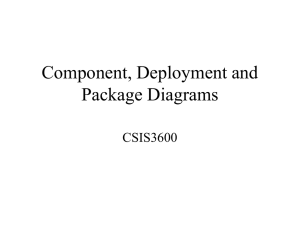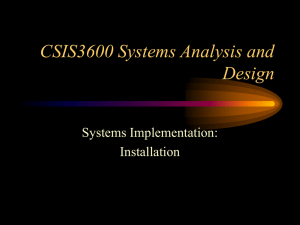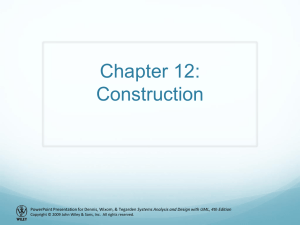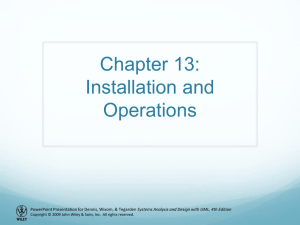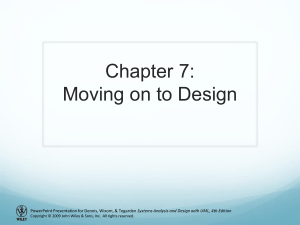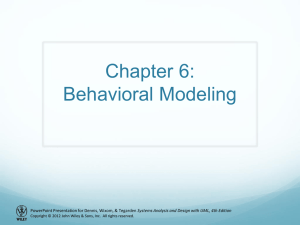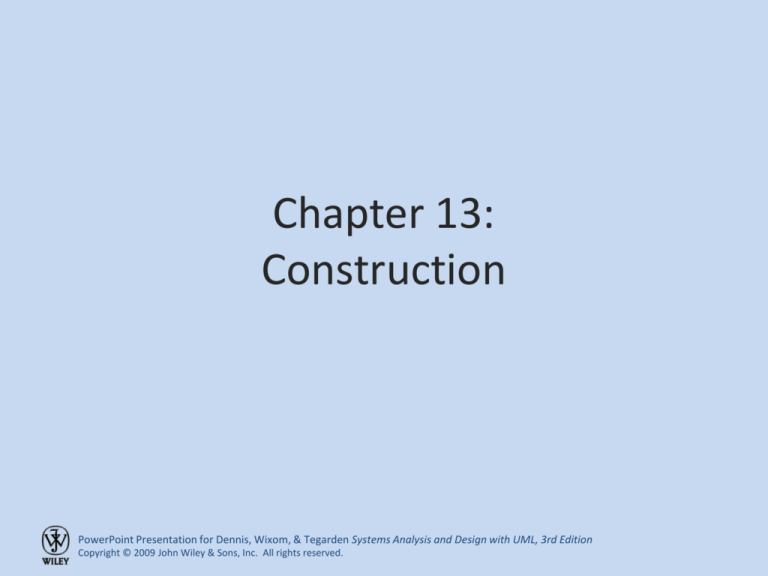
Chapter 13:
Construction
PowerPoint Presentation for Dennis, Wixom, & Tegarden Systems Analysis and Design with UML, 3rd Edition
Copyright © 2009 John Wiley & Sons, Inc. All rights reserved.
Objectives
• Be familiar with the system construction
process.
• Understand different types of tests and when
to use them.
• Understand how to develop documentation.
PowerPoint Presentation for Dennis, Wixom, & Tegarden Systems Analysis and Design with UML, 3rd Edition
Copyright © 2009 John Wiley & Sons, Inc. All rights reserved.
Introduction
• Construction is the development of all parts of
the system, documentation, and new
operating procedures
• Programming is the largest, but least risky part
of systems development
• A program is not considered finished until the
test for that program is passed.
PowerPoint Presentation for Dennis, Wixom, & Tegarden Systems Analysis and Design with UML, 3rd Edition
Copyright © 2009 John Wiley & Sons, Inc. All rights reserved.
MANAGING PROGRAMMING
PowerPoint Presentation for Dennis, Wixom, & Tegarden Systems Analysis and Design with UML, 3rd Edition
Copyright © 2009 John Wiley & Sons, Inc. All rights reserved.
Assigning Programmers
• First, group together related classes, then
assign each group to a programmer
• Time required is proportional to number of
programmers
– The more programmers, the more coordination,
which means less time is spent actually coding
– Best to use a small team of programmers
– Divide complex projects into autonomous parts
PowerPoint Presentation for Dennis, Wixom, & Tegarden Systems Analysis and Design with UML, 3rd Edition
Copyright © 2009 John Wiley & Sons, Inc. All rights reserved.
Coordinating Activities
• Weekly project meetings
• Create and enforce standards
• Divide resources into three areas:
– Development
– Testing
– Production
• Implement change control measures
PowerPoint Presentation for Dennis, Wixom, & Tegarden Systems Analysis and Design with UML, 3rd Edition
Copyright © 2009 John Wiley & Sons, Inc. All rights reserved.
Managing the Schedule
• Time estimates must be revised as
construction proceeds
– Build a 10% error margin into all schedules
• Scope creep occurs when new requirements
are added to the project after the system
design was finalized
• Risk assessments can help predict problems
before they derail the project
PowerPoint Presentation for Dennis, Wixom, & Tegarden Systems Analysis and Design with UML, 3rd Edition
Copyright © 2009 John Wiley & Sons, Inc. All rights reserved.
DESIGNING TESTS
PowerPoint Presentation for Dennis, Wixom, & Tegarden Systems Analysis and Design with UML, 3rd Edition
Copyright © 2009 John Wiley & Sons, Inc. All rights reserved.
Testing
• The purpose of testing is to uncover as many errors
as feasible
– It is impossible to prove the system error-free
– It is too expensive to look for all possible bugs
• Four stages of testing
1.
2.
3.
4.
Unit tests
Integration tests
System tests
Acceptance tests
PowerPoint Presentation for Dennis, Wixom, & Tegarden Systems Analysis and Design with UML, 3rd Edition
Copyright © 2009 John Wiley & Sons, Inc. All rights reserved.
Testing and Object Orientation
•
•
•
•
•
Encapsulation and Information-Hiding
Polymorphism and Dynamic-Binding
Inheritance
Reuse
Object-Oriented Development Process and
Products
PowerPoint Presentation for Dennis, Wixom, & Tegarden Systems Analysis and Design with UML, 3rd Edition
Copyright © 2009 John Wiley & Sons, Inc. All rights reserved.
Test Planning
• Testing takes place throughout the
development of an object-oriented system
• Test plans define a series of tests to be
conducted
• Each test has a specific objective and
describes specific test cases to examine
• Stubs are hard-coded placeholders that allow
testing using unfinished classes
PowerPoint Presentation for Dennis, Wixom, & Tegarden Systems Analysis and Design with UML, 3rd Edition
Copyright © 2009 John Wiley & Sons, Inc. All rights reserved.
Unit Tests
• Unit tests focus on a single class
• Black box testing examines externally visible
behaviors of a class
– Driven by CRC cards and method contracts
– Tester knows nothing of how the class was coded
• White box testing examines the internals of a
class
– Driven by method specifications for the class
PowerPoint Presentation for Dennis, Wixom, & Tegarden Systems Analysis and Design with UML, 3rd Edition
Copyright © 2009 John Wiley & Sons, Inc. All rights reserved.
Rules of Unit Testing
1.
2.
3.
4.
5.
6.
7.
Write the test first
Define the expected output or result.
Don't test your own programs.
Test for invalid or unexpected conditions.
Use reproducible tests
Never write a test that succeeds the first time.
The probability of locating more errors in any one
module is directly proportional to the number of
errors already found in that module.
PowerPoint Presentation for Dennis, Wixom, & Tegarden Systems Analysis and Design with UML, 3rd Edition
Copyright © 2009 John Wiley & Sons, Inc. All rights reserved.
Integration Tests
• Assess whether a set of classes that must
work together do so without error
• Four common approaches
– User interface testing
– Use case testing
– Interaction testing
– System interface testing
• Most projects use all four approaches
PowerPoint Presentation for Dennis, Wixom, & Tegarden Systems Analysis and Design with UML, 3rd Edition
Copyright © 2009 John Wiley & Sons, Inc. All rights reserved.
Final Testing
• System Testing determines
– How well the system meets business requirements
– Usability, security, & performance under load
– Adequacy of documentation
• Acceptance Testing
– Primarily by users with support from project team
– Goals is to confirm that the system is complete
and is acceptable to the users
PowerPoint Presentation for Dennis, Wixom, & Tegarden Systems Analysis and Design with UML, 3rd Edition
Copyright © 2009 John Wiley & Sons, Inc. All rights reserved.
DEVELOPING DOCUMENTATION
PowerPoint Presentation for Dennis, Wixom, & Tegarden Systems Analysis and Design with UML, 3rd Edition
Copyright © 2009 John Wiley & Sons, Inc. All rights reserved.
Developing Documentation
• Documentation of the system must be done
throughout system development
• Two fundamentally different types
– System documentation is for those who install,
maintain or build upon the system
– User documentation is for those who use it
• Assume the users will not read the manuals before
starting to use the system!
• Online documentation is the norm today
PowerPoint Presentation for Dennis, Wixom, & Tegarden Systems Analysis and Design with UML, 3rd Edition
Copyright © 2009 John Wiley & Sons, Inc. All rights reserved.
Types of Documentation
• Reference Documents
– Tell users how to perform specific tasks
• Procedure Manuals
– Describe how to perform business tasks
– Each procedure normally entails multiple tasks
• Tutorials
– teach people how to use major components of a
system
PowerPoint Presentation for Dennis, Wixom, & Tegarden Systems Analysis and Design with UML, 3rd Edition
Copyright © 2009 John Wiley & Sons, Inc. All rights reserved.
Designing Documentation
Structure
• Develop a set of documentation navigation
controls that lead the user to documentation
topics
• Topics generally come from 3 sources
– Commands and menus in the user interface
– How to perform certain tasks
– Definitions of important terms
PowerPoint Presentation for Dennis, Wixom, & Tegarden Systems Analysis and Design with UML, 3rd Edition
Copyright © 2009 John Wiley & Sons, Inc. All rights reserved.
Online Help Example
Navigation
buttons
Task title
Step-bystep
instructions
PowerPoint Presentation for Dennis, Wixom, & Tegarden Systems Analysis and Design with UML, 3rd Edition
Copyright © 2009 John Wiley & Sons, Inc. All rights reserved.
Writing Documentation Topics
•
•
•
•
•
•
•
•
Use the active voice
Use e-prime style
Use consistent terms
Use simple language
Use friendly language
Use parallel grammatical structures
Use steps correctly
Use short paragraphs
PowerPoint Presentation for Dennis, Wixom, & Tegarden Systems Analysis and Design with UML, 3rd Edition
Copyright © 2009 John Wiley & Sons, Inc. All rights reserved.
Summary
• Managing Programming
• Designing Tests
• Developing Documentation
PowerPoint Presentation for Dennis, Wixom, & Tegarden Systems Analysis and Design with UML, 3rd Edition
Copyright © 2009 John Wiley & Sons, Inc. All rights reserved.

